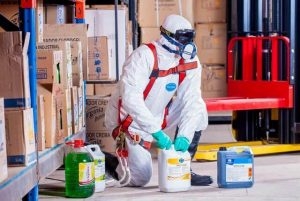
The aim of this article is to provide guidance on the changes to the Personal Protective Equipment at Work Regulations that are coming into force from the 6 April 2022, and how they will affect employers.
Personal Protective Equipment at Work
Employers have a legal duty to manage the risks within the workplace, and the law requires that you must carry out a risk assessment identifying what hazards are within the business that could cause injury or illness, once you have identified those hazards. The next steps are to decide who could be harmed and how, and then you need to take action to reduce the likelihood of harm occurring to so far as is reasonably practicable by implementing control measures.
To illustrate this, in a woodworking workshop, there is a circular saw bench. To start with, the individual carrying out the risk assessment would identify the hazards, for example:
- Exposure to wood dust.
- Flying debris.
- Exposure to noise.
- And so on.
Risk Control Measures
Once you have identified who is affected and how, you need to identify your risk control measures. When considering controls, you should always apply the hierarchy of controls approach.
Starting with elimination, can you physically remove the hazard, for some hazards this might be easier than others, for instance, with manual handling you could eliminate the lifting/carrying requirements by using mechanical aids.
Next is substitution, if the hazard cannot be eliminated, can you replace the hazard, can you switch a piece of machinery to a quieter version, can you switch a hazardous substance to a non-hazardous substance.
Then, continuing moving down the list, can you implement any engineering controls, isolate people from the hazard, a simple one is installing guards, using barriers to cordon the area off.
Afterwards is the introduction of administrative controls, this includes training, safe operating procedures/safe systems of work.
Lastly, you have personal protective equipment (PPE), when needed people should be provided with suitable PPE.
As you can see from the above hierarchy of controls PPE is considered to be the last resort. So when considering controls the first point of call should always be can the hazard be eliminated. When working through the hierarchy list, you should always consider every hierarchy control as you have a duty to reduce the risk as low as reasonably practicable.
There will still be hazards where employees are at risk of harm occurring if PPE is not considered and issued. Linking back to my initial example of a circular saw bench, as the machinery can cause flying debris eye protection should be worn.
Changes to Personal Protective Equipment at Work
Currently there are no changes to the duties and responsibilities outlined in the Personal Protective Equipment at Work Regulations 1992 however, the new amended regulations will now extend the regulations to cover limb (b) workers.
What do we mean by a limb (b) worker? A Limb (b) worker as defined by the HSE is:
- “Carry out casual or irregular work for one or more organisations.
- After 1 month of continuous service, receive holiday pay but not other employment rights such as the minimum period of statutory notice.
- Only carry out work if they choose to.
- Have a contract or other arrangement to do work or services personally for a reward (the contract does not have to be written) and only have a limited right to send someone else to do the work, for example swapping shifts with someone on a pre-approved list (subcontracting).
- Are not in business for themselves (they do not advertise services directly to customers who can then also book their services directly).”
Generally, a limb (b) worker is someone defined as a ‘dependent contractor,’ who carries out the work personally rather than sending someone else on their behalf.
How do the amended regulations affect me as an employer who have both employees and limb (b) workers? Your limb (b) workers should be treated the same as your employees so as part of the risk assessment process if PPE is identified to be worn then it should be provided free of charge to both your employees and to limb (b) workers. If you as the employer only have limb (b) workers, then you are legally required from the 6 April to provide PPE free of charge to them where it has been identified in the risk assessment as a requirement to be worn. The changes to the regulations will not apply to those who have a ‘self-employed’ status.
What is Defined as PPE?
PPE is defined as equipment provided to the user that will protect their health and safety against the risks arising from their work/work environment. PPE can include items such as safety helmets, hard hats, gloves, eye protection, safety footwear and safety harnesses.
However, from that list, you may notice that hearing protection is missing and the reason for this is because hearing protection falls within Regulation 7, of The Control of Noise at Work Regulations 2005 which defines when hearing protection should be worn by employees.
Likewise, respiratory protective equipment is not covered by these regulations as well as they also too have their own specific regulations that apply to them such as The Control of Substances Hazardous to Health Regulations 2002 (as amended).
Once you have established that PPE is required to be worn then you should provide to your workers a PPE equipment issue record, this is to demonstrate that workers have been issued with the PPE and that they understand how to use it, maintain it and how/where to store it. Where PPE is issued to workers, all workers should be trained in its use and why it is required to be worn. Workers should be advised on if they identify any damage or defects with their PPE who to report this to so that a replacement can be sought.
Workers should be informed of how to store their PPE, and not just let their PPE to be left lying around where it could easily get damaged or lost.
Employer & Employee Resonsibility
Like with any measure that has been implemented to ensure the health, safety and welfare of any employee/worker it's essential that it's properly monitored. Some employees/workers may forget to put their PPE on, thinking they will be fine without it. However as they are still being exposed to potential dangers, monitoring will enable you as an employer to check that employees/workers are following the control measures correctly, that PPE is worn correctly and worn when it is supposed to be worn.
Often or not, employees and workers may share PPE and this should only be considered when the PPE is only required for limited periods. Where it is shared, it must be properly, cleaned and sanitised to reduce the spread of infections/illnesses. Ideally, PPE should be issued to each person on a personal basis.
When an enforcement officer visits the workplace, as part of their inspection, they will monitor and check to see if workers are wearing the required PPE. Businesses that do not comply with the regulations could be subject to enforcement action which range from a verbal or written discussion, improvement and prohibition notices, to in the most extreme cases prosecution. Remember, if an Officer from the HSE visit, and identify a material breach of health and safety law they can start charging for their services, which is known as a fee for intervention, which at present costs, £160 an hour.
To conclude, from the 6 April 2022, the Personal Protective Equipment at Work (Amendment) Regulations will come into force extending the duties to cover limb (b) workers. Speak to our team of Health and Safety Consultants for guidance surrounding PPE and any other safety issues you need help with.



